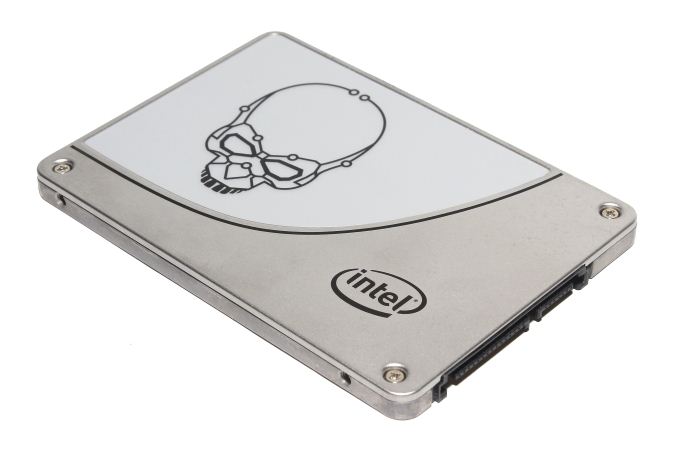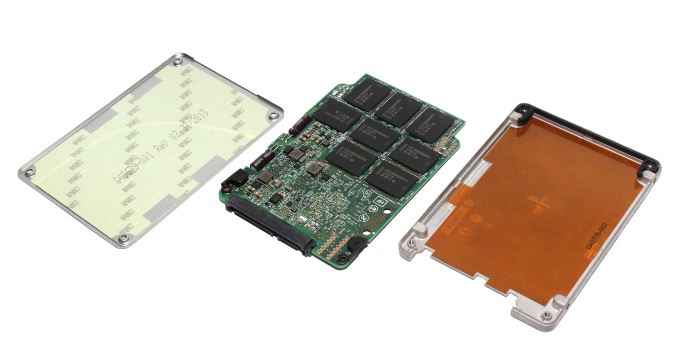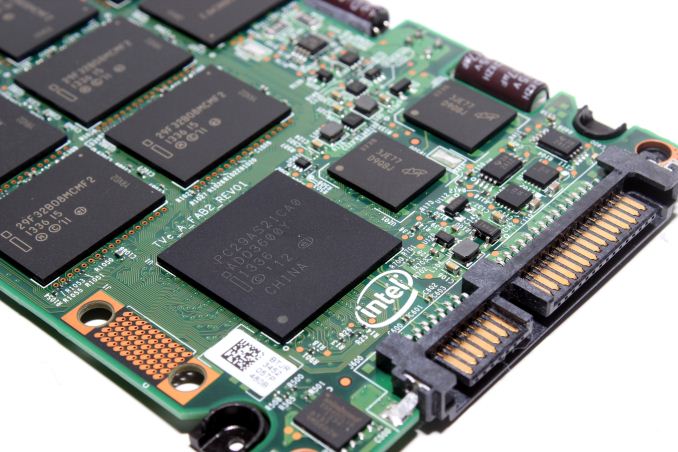Intel SSD 730 (480GB) Review: Bringing Enterprise to the Consumers
by Kristian Vättö on February 27, 2014 12:00 PM EST- Posted in
- Storage
- SSDs
- Intel
- Intel SSD 730

The days of Intel being the dominant player in the client SSD business are long gone. A few years ago Intel shifted its focus from the client SSDs to the more profitable and hence alluring enterprise market. As a result of the move to SandForce silicon, Intel's client SSD lineup became more generic and lost the Intel vibe of the X-25M series. While Intel still did its own thorough validation to ensure the same quality as with its fully in-house designed drives, the second generation SandForce platform didn't allow much OEM customization, which is why the SSD 520 and other SandForce based Intel SSDs turned out to be very similar to the dozens of other SandForce driven SSDs in the market.
The SSD market has matured since the X-25M days and a part of the maturing process involves giving up profits. Back in 2007-2008 the SSD market (both client and enterprise) was a niche with low volume and high profits, so it made sense for Intel to invest in custom client-oriented silicon. There wasn't much competition and given Intel's resources and know-how, they were able to build a drive that was significantly better than the other offerings.
The high profits, however, attracted many other manufacturers as well and in the next few years Intel faced a situation it didn't like: profit margins were going down, yet bigger and bigger investments had to be made in order to stay competitive in the client market. OCZ in particular was heavily undercutting Intel's pricing and big companies with technological and scale advantage like Intel tend not to like the bargain game because at the end of the day it's not as profitable for them. The enterprise market is a bit different in this regard because price is not usually the commanding factor; instead the focus is on reliability, features and performance, which made it an easy choice for Intel to concentrate its resources on covering that market instead.
For the majority of consumers this change in focus was negligible since the likes of Micron and Samsung had started paying attention to the retail consumer SSD market and Intel was no longer the only good option available. However, enthusiasts were left yearning for an Intel SATA 6Gbps design as many had built brand loyalty for Intel with the X-25M. In late 2012 the wishes materialized but to their disappointment only in the form of an enterprise SSD: the DC S3700. This verified that enterprise was Intel's first priority but given that it was a SATA 6Gbps rather than a PCIe design, it left hope for a more client-orientated in-house Intel solution. Fast-forward to today and that solution is now here. Please meet the SSD 730, Intel's new client flagship.
Adopting the platform from the DC S3500/S3700, the SSD 730 is Intel's first fully in-house designed client drive since the SSD 320. The SSD 730 is not just a rebranded enterprise drive, though, as both the controller and NAND interface are running at higher frequencies for increased peak performance. While the branding suggests that this is an enterprise drive like the SSD 710, Intel is marketing the SSD 730 directly to consumers and the DC S3xxx along with the 900 series remain as Intel's enterprise lineups. And in a nod to enthusiasts, the SSD 730 adopts the Skulltrail logo to further emphasize that we are dealing with some serious hardware here.
| Capacity | 240GB | 480GB |
| Controller | Intel 3rd Generation (SATA 6Gbps) | |
| NAND | Intel 20nm MLC | |
| Sequential Read | 550MB/s | 550MB/s |
| Sequential Write | 270MB/s | 470MB/s |
| 4K Random Read | 86K IOPS | 89K IOPS |
| 4K Random Write | 56K IOPS | 74K IO |
| Power (idle/load) | 1.5W / 3.8W | 1.5W / 5.5W |
| Endurance | 50GB/day (91TB total) | 70GB/day (128TB total) |
| Warranty | Five years | |
| Availability | Pre-orders February 27th - Shipping March 18th | |
Intel is serious about the SSD 730 being an enterprise-class drive for the client market as even the NAND is pulled from the same batch as Intel's MLC-HET NAND used in the S3700 and the endurance rating is based on JEDEC's enterprise workload. JEDEC's SSD spec, however, requires that client SSDs must have a data retention time of one year minimum whereas enterprise drives must be rated at only three months, which gives the S3500/S3700 a higher endurance. MLC-HET also trades performance for endurance by using lower programming voltages, resulting in less stress on the silicon oxide.
| Intel SSD 730 | Intel SSD 530 | Intel SSD DC S3500 | Intel SSD DC S3700 | |
| Capacities (GB) | 240, 480 | 80, 120, 180, 240, 360, 480 | 80, 120, 160, 240, 300, 400, 480, 600, 800 | 100, 200, 400, 800 |
| NAND | 20nm MLC | 20nm MLC | 20nm MLC | 25nm MLC-HET |
| Max Sequential Performance (Reads/Writes) | 550 / 470 MBps | 540 / 490 MBps | 500 / 450 MBps | 500 / 460 MBps |
| Max Random Performance (Reads/Writes) | 89K / 75K IOPS | 48K / 80K IOPS | 75K / 11.5K IOPS | 76K / 36K IOPS |
| Endurance (TBW) |
91TB (240GB) 128TB (480GB) |
36.5TB |
140TB (200GB) 275TB (480GB) |
3.65PB (200GB) 7.3PB (400GB) |
| Encryption | - | AES-256 | AES-256 | AES-256 |
| Power-loss Protection | Yes | No | Yes | Yes |
Continuing with the enterprise features, there is full power-loss protection similar to what's in the S3500/S3700. I'm surprised that we've seen so few client SSDs with power-loss protection. Given the recent studies of power-loss bricking SSDs, power-loss protection should make a good feature at least in the high-end SSDs.
Test System
| CPU |
Intel Core i5-2500K running at 3.3GHz (Turbo and EIST enabled) |
| Motherboard | AsRock Z68 Pro3 |
| Chipset | Intel Z68 |
| Chipset Drivers | Intel 9.1.1.1015 + Intel RST 10.2 |
| Memory | G.Skill RipjawsX DDR3-1600 4 x 8GB (9-9-9-24) |
| Video Card |
Palit GeForce GTX 770 JetStream 2GB GDDR5 (1150MHz core clock; 3505MHz GDDR5 effective) |
| Video Drivers | NVIDIA GeForce 332.21 WHQL |
| Desktop Resolution | 1920 x 1080 |
| OS | Windows 7 x64 |
Thanks to G.Skill for the RipjawsX 32GB DDR3 DRAM kit












96 Comments
View All Comments
Kristian Vättö - Saturday, March 1, 2014 - link
The endurance is based on a workload that consists mainly of 4KB random writes (I'm currently travelling and don't have the JDEC PDF at hand, but IIRC it was ~67% 4KB and then a variety of other IO sizes).The figures Intel provide are in-line with others. E.g. OCZ rates the Vector 150 at 50GB/day for 5 years. Consumer-grade drives are not validated as extensively as enterprise drives, hence the endurance ratings are lower. Furthermore, it's mainly a way to force enterprises to use enterprise drives because otherwise they could just throw in some consumer drives and then get them replaced under warranty when the drives wear out.
Gigaplex - Thursday, February 27, 2014 - link
"Even though the performance consistency on the SSD 730 is great, it's only mediocre in our Storage Bench 2013. The write performance of SSD 730 is class-leading but as our Storage Bench has more read than write operations, the SSD 730 loses to drives with better read performance."Uh... your graphs show it near the top of the charts for read, and in the bottom half for write. This comment makes no sense.
creed3020 - Friday, February 28, 2014 - link
Excellent point. This is review is filled with holes that tout this drive yet the numbers don't back it up.For it's price the drive is a non starter. I have a Seagate 600 240GB which I purchased for $139, that is a staggering $110 less than the 240GB equivalent here from Intel. The 5-10% performance improvement this drive has over my drive is not worth the price difference. Intel resting on it's laurels as usual.
CalaverasGrande - Thursday, February 27, 2014 - link
orientated?eanazag - Thursday, February 27, 2014 - link
What was left out of this review and it is understandable is how it handles various RAID configurations over time. More than RAID 0 or 1. I think that may be the more realistic usage model.I agree with most others. I am not seeing much traction for it because of pricing and lack of features. Maybe professionals. I'd need to look at this and the DC models to decide based on price.
bitcoder - Friday, February 28, 2014 - link
I agree on the RAID comments, since this is an "enterprise" ssd lets see how it works in tougher environment. Put some in a RAID configuration and then compare them against the other RAIDed drives in your bin. Consistent performance is a critical parameter when you put drives in parallel as the slowest one on any operation slows down the whole array.I disagree on the lack of features, I think a power loss (backup power caps) is much more likely than computer theft (encryption) of a desktop at my house. Maybe they had to turn off encryption because it was the slowest part of the silicon and prevented reaching these overclocking speeds.
chizow - Thursday, February 27, 2014 - link
Great synopsis and analysis of the evolution of SSDs since Intel's X-25M hey day, just as I recounted the events as well for the most part.I just don't see how Intel will sell many of these at the listed MSRPs, from what I saw it is still slower than the top 3 SSDs on the market (Samsung 840Pro, Sandisk Extreme II, Samsung 840Evo 250+GB) and it is much later and more expensive than the Extreme II and 840 Evo at least.
iwod - Thursday, February 27, 2014 - link
I am slightly disappointed.The Intel DC brings SSD Random IO consistency to the table. At the time where you can actually still feel pause on some pretty decent SSD. It was good because we reached the upper limit of Seq Performance with no replacement for SATA 6Gbps in sight, and Random Read Write has nearly level off between most SSDs.
Since then, most other top end SSD, from Latest Marvel Controller to Samsung has all provide very good consistency. As shown in the graph SANDISK Random IO variation are all well within 1x% range. And doesn't have Dot jumping everywhere on the graph. The same goes for Samsung as well. While Intel still brings the best consistancy performance, but it doesn't seems to me the tradeoff are worth it. From performance enthusiast perspective, Seq and Random IO still comes first. As shown in the Storage Bench the SSD 730 isn't the top performer, the highest power usage, and the most expensive as well.
What we need now is improvement on all front. Much faster Seq Performance, even PCI-E 3.0 x 2 will only brings us 2GB/s, which i guess will only take a year and half for SSD marker to saturate it. Faster Random IO, and finally much lower Power usage.
Samus - Thursday, February 27, 2014 - link
Considering you can buy two m500 drives for the price of one of the 730's, your better off raiding them together and getting superior performance, endurance, redundancy, and far less idle power consumption.Cost aside, this controller makes no sense for anything but a SQL, Exchange, web or heavy IO file server. The only desktop platform that'll take advantage of the performance consistency is video editing, but at 240 and 480 GB the capacities aren't high enough.
amddude10 - Friday, November 28, 2014 - link
The 730's power loss protection is supposedly much, much better than that of the m500